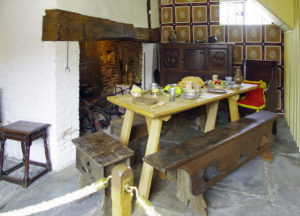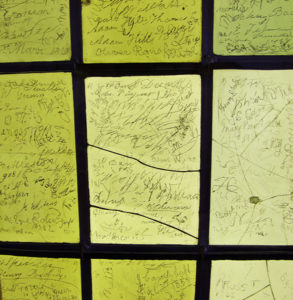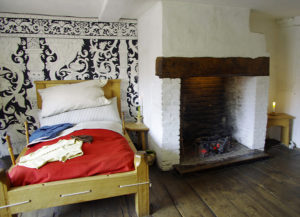The lure of the Bard is strong and this is on the tick list of nearly everyone visiting Stratford upon Avon. Most are not interested in the house but just want to stand in the room where William was born. I joined them, having bought a Town House Pass (buy on line for a 10% reduction) which gave me entry to the Birthplace, Hall’s Croft and New Place.
It is a lovely timber frame house standing on Henley Street in the centre of Stratford, but don’t be fooled this isn’t the house Shakespeare would have recognised. It has had a chequered history and was extensively restored by the Victorians. There is even a small patch on the front left exposed to show the wattle construction below the daub.
Little is known of the history of the house and when it was built. John Shakespeare, William’s father came to live here on his marriage to Mary Arden. He was a wealthy glove maker and wool dealer and ran his business from the premises. He was a man of standing in Stratford and was an Alderman and Bailiff. They had eight children. After John’s death, William inherited the house and spent the first five years of his married life with Anne Hathaway here. When he moved to London, the property was let out and became an inn, but gradually became very run down.
There was a rekindling of interest in Shakespeare in the C18th and the first of the visitors to the house included people like Charles Darwin and Sir Walter Scott. Visitors scratched their autographs on the windows. In 1847, the American showman PT Barnum wanted to buy the house to ship it back to the States. To prevent this, the Shakespeare Birthplace Trust was set up to buy and restore the house.
The Shakespeare family only lived in part of the house you see today. The small attached cottage on the left known as Hart’s House, was built after the main house and was lived in by the descendants of one of Shakespeare’s sisters. The extension at the back was added in the C17th when the house became an inn. The house Shakespeare knew would have had the workshop and shop on one side of the ground floor with the living area in the other half, separated by the cross passage. Stairs from here led to the bedrooms on the first floor.
Entry is round the back of the house. The garden is a modern planting. The area would originally have been used to process skin and leather for glove making. The modern building at the side of the garden houses an exhibition entitled
“”Famous beyond Words”,”:https://www.shakespeare.org.uk/visit/shakespeares-birthplace/famous-beyond-words/ https://www.shakespeare.org.uk/visit/shakespeares-birthplace/famous-beyond-words/ a modern interpretation of Shakespeare and his work.
Visitors enter into Hart’s Cottage and there is a small exhibition area with a copy of Shakespeare’s First Folio and family artefacts. These include the document granting Shakespeare’s daughter Susanna and her husband a pew in Holy Trinity Church and a C19th wooden goblet which may have been carved from wood from the pew Shakespeare used in the church. This is the closest you are likely to get to Shakespeare.
There is no information about the first room but the costumed interpreter explained this was the parlour. It was the warmest room in the house and would have functioned as the guest bedroom and was also the place where business was conducted and important guests entertained. The walls are covered with painted canvas, a cheaper alternative to tapestry. This has the original limestone floor, the only one in the house and the only thing in the house which has a direct connection to Shakespeare… The paper mache figure sprawling on the floor was made as an exam project by a student, and is only here as a ‘temporary measure’.
Beyond is the hall, which was where the family would have eaten and their main living area. Again walls are covered with painted canvas, although the wall at the front of the house still has the exposed wooden beams.
Beyond is the workshop where gloves were made and sold. Goat, calf, deer and dog skin was used to make gloves and would have been tanned in the back yard. They were lined with rabbit skin. William probably helped when he was growing up as his work is full of references to glove making.
Stairs lead to the first floor where there are three bedrooms. The boys slept in the first room. This lacked privacy as everyone had to go through it to reach the other two bedrooms. It is sparsely furnished. Above, and reached by a ladder was an area used for storage and where the servants slept.
Through this on the left was the room used by the girls. This has display cases with artefacts from David Garrick who staged the first Shakespeare Festival in 1769, really putting Shakespeare on the tourist map. In here is the ‘birthplace window’ which was inscribed by early tourists to the house.
On the right is what every visitor has come to see – the birthroom. At least, it is assumed this is the room Shakespeare was born in. To be honest, there isn’t a lot to see and what there is has no direct contact with Shakespeare and is very much an interpretation of what the room may have been like. I felt the whole experience was a bit scruffy and tacky. The marital bed was the ‘Second Best Bed’ after the guest bed, which is why Shakespeare left his second best bed to Anne Hathaway in his will.
The tour finishes in the C17th extension at the back of the house which was built when it became an inn. At one time it had thirteen rooms. Wealthier visitors would have had four poster beds. The less wealthy made do with a straw mattress on the floor. There was another paper mache model in here, King Lear, who looked decidedly under the influence.
Downstairs were the food preparation areas and drinking area, all looking remarkably clean and with remarkably modern looking furniture.
All in all I left feeling very disappointed by the whole experience – cheated if you like. There are information leaflets for foreign visitors but none in English. Hall’s Croft provide laminated A3 sheets but not here. When I asked about this I was told visitors didn’t return these. I felt this was an unacceptable answer.
There is also little information in the rooms although the costumed interpreters are knowledgeable and willing to talk and answer questions. What there is in the house has no direct link to Shakespeare or his family. The painted canvas on the walls was looking past its best and many rooms were sparsely furnished. The two rather naff paper mache figures had seen better days and didn’t add anything to the experience. Hopefully they will have gone by now.
I accept that most people just want to stand in the birthroom and breathe the air Shakespeare breathed…. I left not much the wiser and felt this was a missed opportunity. Hall’s Croft where Shakespeare’s daughter and husband lived is completely different and much nicer to visit. It doesn’t get the crowds either.
The guide books warn you that the Birthplace does get very busy and to plan to visit early. It was lunchtime when I went at the end of May and I was surprised how quiet the house was. Try and avoid going in with a booked group. As usual you are taken out through the shop which is in another rather nice timber frame building but of ‘no interest’ as it has no links to Shakespeare….
There are lots more pictures “here.”:http://wasleys.org.uk/eleanor/stately_homes_castles/england/westmidlands/birthplace/index.html
The post code is CV37 6QW and the grid reference is SP 200551. Henley Street is pedestrianised and the nearest car park is on Windsor Street.
DISABLED ACCESS
There is no parking for the house, although there are some blue badge spaces at the top of Henley Street. There is level access to the ground floor rooms but none to the first floor rooms which include the birthroom. There is however, a touch screen with a 3D tour or an audio tour. There is an accessible toilet. There is a concessionary rate for visitors with disabilities and carers are admitted free.










